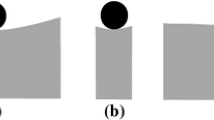Abstract
A class of macrosystems is considered which involves the self-reproduction and redistribution of macrosystem elements. It is assumed that the relaxation time of the self-reproduction process significantly exceeds that of the redistribution process. The mathematical model of this macrosystem is used to study the evolution of a regional system consisting of centres linked by a network. The bifurcation of critical points of such a system is investigated.
Similar content being viewed by others
References
Allen PM, Sanglier M (1979) A dynamic model of growth in a central place system. Geographical Analysis 11:256–272
Allen PM, Sanglier M (1981) Urban evolution, self-organization and decision making. Environ Plan A13:167–183
Allen PM, Denenbourg JL, Sanglier M, Boon F, de Palma A (1977) Dynamic urban models. Reports to the Department of Transportation; contracts TSC-1185, TSC-1460
Andersson AE, Batten DF (1988) Creative nodes, logistical networks and the future of the metropolis. Transportation 14:281–293
Batty M, March L (1976) Dynamic urban models based on information — minimizing. Geographical Papers, no 48, University of Reading
Beaumont JR, Clarke M, Wilson AG (1981) The dynamics of urban spatial structures. Environ Plan A13:401–420
Clarke M (1981) A note on the stability of equilibrium solutions of production-constrained spatial interaction models. Environ Plan A13:601–604
Clarke M (1985) The role of attractiveness functions in the determination of equilibrium solutions to production-constrained spatial interaction models. Environ Plan A17:175–183
Clarke M, Wilson AG (1983) The dynamics of urban spatial structure: progress and problems. J Reg Sci 23:1–18
Dendrinos DS (1990) On spatial heterogeneity, relative dynamics and chaotic behaviour. Social-Spatial Dynamics, Urban and Transportation Dynamics Laboratory, Transportation Center Kansas City
Griffith DA, Haining RP (eds) (1986) Transformations through space and time. Nijhoff, Dordrecht
Haken H (1975) Synergetics, an introduction. Springer Series Synergetics 1. Springer, Berlin Heidelberg New York
Harris B, Wilson A (1978) Equilibrium values and dynamics of attractiveness terms in production-constrained spatial-interaction models. Environ and Plan 10:371–388
Imelbajev SS, Popkov YS, Chernis KV (1987) Dynamic models of macrosystems with self-reproduction and balancing distribution and their application to analysis of urban transportation system. In: Shmuliyan BL (ed) Transportation system, VNIISI, Moscow, pp 69–77 (in Russian)
Leonardi G (1978) Optimal facility location by accessibility maximizing. Environ Plan A10:1287–1305
Lombardo ST, Rabino GA (1986) Calibration procedures and problems of stability in nonlinear dynamic spatial interaction modelling. Environ Plan A18:341–350
Long LH (1970) On measuring geographical mobility. J Am Stati Assoc 65:1195–1203
Long LH, Boertlein CG (1976) The geographical mobility of Americans: an international comparison. US Bureau of the Census series P-26, no 64, United States Department of Commerce, Washington, DC
Popkow YS (1980) Simulation and analysis of structural properties of human settlement systems by means of entropy maximising models. Environ Plan A12:1165–1190
Popkov YS (1985) An elements of macrosystems theory. Moscow, VNIISI, preprint (in Russian)
Popkov YS (1986) Mathematical models of macrosystem stationary states: principles of formulation, analysis of properties and algorithms. Large Scale Syst 10:1–20
Popkov YS (1987) A new class of dynamic models of macrosystems with self-reproduction and local-thermodynamical distribution. In: Afanasiev AP (ed) The optimal control of dynamic macrosystem. VNIISI, Moscow, pp 18–27 (in Russian)
Popkov YS (1988) The local-stationary models of nonequilibrium dynamic of macrosystems with self-reproduction. Proceedings of the USSR Academy of Sciences 303, no 3 (in Russian)
Popkov YS (1989) A new class of dynamic macrosystem models with self-reproduction. Environ Plan A21:739–751
Popkov YS, Posokhin MM, Gutnov AE, Shmulyian BL (1984) System analysis and problems of urban development. Nauka, Moscow (in Russian)
Posokhin MM, Gutnov AE, Popkov YS, Shmulyian BL (1980) A systems model of the city and experiments in using if for a functional and spatial analysis of Moscow. Environ Plan B 7:107–119
Prigogine J, Herman R, Allen P (1977) The evolution of complexity and laws of nature. In: Laszio E, Bierman T (eds) Goals in global community: a report to the Club of Rome, vol 1, Pergamon Press, Oxford
Pumain D, Sanders L, Saint-Tulien T (1989) Villes et Auto-Organisation. Economica
Puu T (1985) A simplified model of spatiotemporal population dynamics. Environ Plan A17:1263–1269
Puu T (1987) Complex dynamics in continuous models of the business cycle. Lecture notes in economics and mathematical systems, vol 293, pp 227–259. Springer, Berlin Heidelberg New York
Puu T (1988) On spatiotemporal dynamics of capital and labour. In: Batten D (ed) Studies in regional science and urban economics. North-Holland, Amsterdam
Rogers A (1975) Introduction in multiregional demography. Willey, New York
Rogers A, Willekens F (1978) Migration and settlement: measurement and analysis. IIASA Report RR-78-13, August. Laxenburg, Austria
Roy JR, Brotchie JF (1984) Some supply and demand considerations in urban spatial interaction models. Environ Plan A16:1137–1147
Shwetsov VI (1988) Some properties of dynamic models of macrosystem. In: Popkov YS (ed) The applied problems of macrosystems management, VNIISI, Moscow, pp 29–35 (in Russian)
Shwetsov VI (1989) The stationary states and bifurcation in dynamic regional models. In: Popkov YS (ed) Dynamic of nonhomogeneous systems. VNIISI, Moscow (in Russian)
Sonis M (1981) Flows, hierarchies, potentials. Environ Plan 13:413–420
Weidlich W, Haag G (eds) (1988) Interregional migration: dynamic theory and comparative analysis. Springer, Berlin Heidelberg New York
Wilson AG (1967) A statistical theory of spatial distribution models. Transp Res 1:253–269
Wilson AG (1970) Entropy in urban and regional modelling, Pion, London
Wilson AG (1974) Urban and regional models in geography and planning. Wiley, New York
Wilson AG (1981) Catastrophe theory and bifurcation. Applications to urban and regional systems. Croom Helm, London
Zelinsky W (1971) The hypothesis of the mobility transition. Geogr Rev 46:219–249
Author information
Authors and Affiliations
Rights and permissions
About this article
Cite this article
Popkov, Y.S. Dynamic models of macrosystems with self-reproduction and their application to the analysis of regional systems. Ann Reg Sci 27, 165–174 (1993). https://doi.org/10.1007/BF01581944
Received:
Accepted:
Issue Date:
DOI: https://doi.org/10.1007/BF01581944



